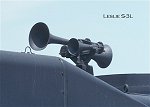Leslie S-3L | ||
|---|---|---|
 | ||
S-3L is a shorthand designation for any Leslie 3-chime Supertyfon horn that uses the
#25, 31, and 44 bells (the "L" chord). The actual model designation of a given horn will
have additional prefixes and suffixes as follows. | ||
 | The very earliest S-3L's produced in the early 50's featured bronze power chambers and two-piece bells. The mounting tabs around the periphery of the power chambers disappeared from the design about 1970. Horn and photo courtesy Brent Lee. | |
 | An RS-3L-RO. The R prefix indicates the use of the redesigned, spiked back caps (the "RS" modifications) which were introduced around 1980 in an attempt to reduce the horn's susceptibility to fouling. Inside, a stiffer, one-piece diaphragm replaced the earlier two-piece diaphragm, which resulted in a somewhat harsher sound. | |
 | An SL-3L-R. The L prefix indicates the use of the low profile manifold, which is shaped like a triangle. This horn also has the older style domed back caps, and is mounted on an extension so that the sound from the reversed #44 bell isn't blocked by the air conditioner box behind it. | |
 | A pair of modified
RSU-3L-LR horns. Taking the designation one letter at a time:
| |
  | Leslie also made two chime and one chime horn manifolds, and if desired, a multichime horn could be spread over several manifolds. The Santa Fe GP30 pictured above has the equivalent of an S-3L, with the #31 and 44 bells on a two chime manifold on the engineer's side, and the #25 bell on a single manifold on the fireman's side. | |
 | "Standard arrangements" notwithstanding, railroad horn shops can arrange the S-3L's horn bells any which way they choose. On this rearranged RS-3L-R, the #25 and 44 bells have switched places, and the #31 bell is reversed rather than the #44. | |
The S-3L was introduced in the early 1950's as competition for the Nathan M-3. It rapidly became one of the most popular 3-chime airhorns ever produced. The S-3L was used extensively by Santa Fe, Union Pacific, Milwaukee Road, Soo Line, Missouri-Kansas-Texas (MKT), Chicago & Northwestern, Kansas City Southern, Erie Lackawanna, Reading, and many others. Prime Manufacturing Corp. of Oak Creek, WI produced a horn identical to the S-3L, which they called the PM-920. | ||
Factory tuning is: 255, 311, and 440 Hz (approximately C, D#, A)
| ||
The S-3L was one of the most common multichime airhorns used by US railroads.
In recent years, most of the large roads that used the S-3L have turned to Nathan horns instead.
The horn remains in decreasing numbers on BNSF and former Conrail locomotives, as well as
on regionals and shortlines nationwide.
| ||
S-3L sound samples:Brent Lee's early S-3L (pictured above):Sample 1...555kB...25 seconds Santa Fe, various locomotives: Sample 1...268kB...12 seconds Sample 2...156kB...7 seconds Sample 3...144kB...6 seconds Sample 4...479kB...22 seconds Sample 5...458kB...21 seconds Sample 6...533kB...24 seconds Conrail, various locomotives: Sample 1...310kB...14 seconds Sample 2...878kB...40 seconds Union Pacific, various locomotives: Sample 1...167kB...7 seconds Sample 2...373kB...17 seconds When bad things happen to good horns:Early Supertyfons tended to get fouled easily by dirty/oily supply air or from foreign matter entering the horn. This caused bells to go silent or harmonically overblow (squeal). The RS modifications mentioned above helped to an extent, but squealing Leslies can still be found, particularly when the horns have the largest available orifices. With the advent of the North American safety cab and its button-actuated solenoid horn valve, the horn is instantly subjected to the full force of the air blast, resulting in greater wear and a tendency for bells to sound poorly or quit sounding altogether. Below are a few examples of S-3L's in various states of deterioration.
| ||